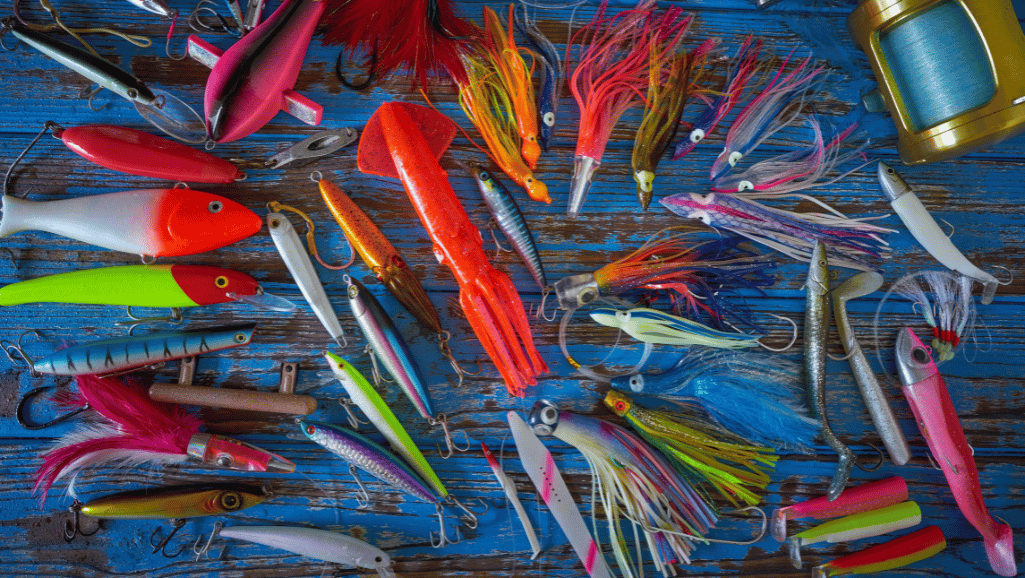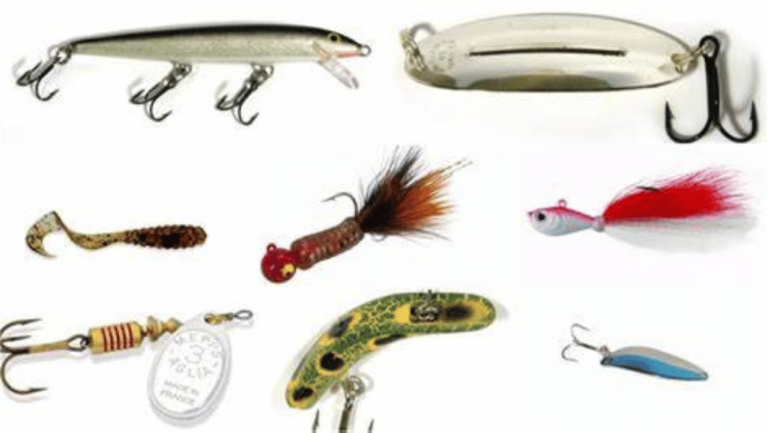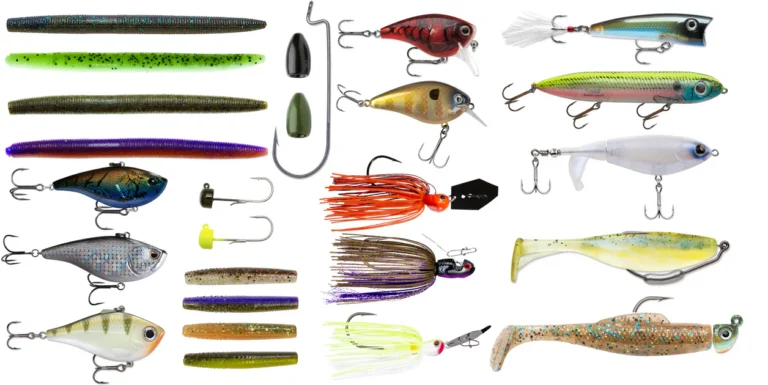Anglers and craft lovers can enjoy making their own fishing lures. Starting with step-by-step lure crafting gives anglers unique lures and a personal touch to their fishing. This DIY fishing lure guide makes it easy to create custom bait for your fishing trips.
Creating your own fishing lures combines art and practicality. Influencers like Haru834 on YouTube show how to adapt complex designs for personal use. For example, turning a 65-mm minnow into a 50-mm lure is great for BFS fishing. This shows how easy and versatile homemade fishing bait tutorials can be.
You don’t need a lot of tools to start making lures. With a simple workspace and this guide, you can make professional-looking lures. The BFS system is perfect for beginners, using a downsized balsa minnow to learn the basics of lure making.
The Basics of DIY Fishing Lure Making
Key Takeaways
- Understand the synergy between art and function in crafting effective homemade lures.
- Learn about the advantages and satisfaction that come from producing custom fishing baits.
- Explore proven designs and learn to scale them for different fishing techniques like BFS.
- Discover the minimal tools needed to start crafting your own lures at home without a full workshop.
- Find inspiration and guidance from experienced crafters and leverage platforms such as YouTube to enhance your skills.
- Benefit from the economical and satisfying experience of making multiple lures simultaneously for cost-efficiency.
- Embrace the trial-and-error process, conducive to perfecting lure crafting techniques.
The Basics of DIY Fishing Lure Making
Learning how to make fishing lures is a mix of art and practical skills. It lets you create handmade fishing lures that show off your creativity and knowledge of fishing. Each lure you make is a personal reflection of your craft.
Understanding the Lure Making Process
At the heart of lure making techniques is choosing the right materials and shapes. Whether you’re making soft plastics or hard-bodied lures, the type affects how they move, look, and attract fish. DIY fans often try different materials to see what works best in various fishing situations. This way, they can make lures that are uniquely suited to their fishing needs.
Benefits of Crafting Your Own Lures
Making your own lures is more than just a hobby; it’s a journey of discovery and pride. Seeing your handmade fishing lures catch fish is incredibly rewarding. It also lets anglers tailor their gear to the fishing conditions and the fish they’re after. This makes fishing more effective and enjoyable.
Types of Homemade Fishing Lures
The world of homemade fishing lures is vast, from jig heads and soft plastics to spinnerbaits and crankbaits. Each lure type is suited for different fishing situations and fish species. Learning the basics of making your own lures opens up endless possibilities for customization.
- Soft plastics can be molded into almost any shape, targeting a variety of fish.
- Hard-bodied lures like crankbaits and poppers are great for fishing on the surface.
- Metal spoons and spinners are excellent for attracting big fish with their shiny appearance and movement.
With so many options, anglers can always have the perfect lure for the job. Learning how to make fishing lures is a key skill for any serious angler looking to improve their fishing techniques.
Gathering Your Lure Making Materials and Tools
Starting to make your own fishing lures means getting the right materials and tools. This step is crucial for making lures that work well and last long. It doesn’t matter if you’re new or experienced at fishing. Let’s look at what you need to get started.
List of Necessary Lure Making Supplies
For making fishing lures, you’ll need special items. You’ll use tools like craft knives and pliers, but also things like Plastisol. This liquid plastic is key for making soft baits. It comes in different textures, like soft for more action or medium for balance.
- Balsa, Basswood Sheets – Great for making buoyant and easy-to-shape lure bodies
- Steel Wire – Important for giving structure to through-wire lures
- VMC Hooks and Small Split Rings – Great for setting up your lures
- Glass Epoxy Boards – Ideal for making strong, water-resistant lure bases
- Plastisol (Soft, Medium, Hard) – Essential for molding flexible, appealing lures
Choosing the Right Wood for Lure Bodies
When picking materials for making fishing lures, the wood is key. Balsa and basswood are favorites because they’re light and easy to work with. Here are five woods often used:
- Balsa – Very buoyant and simple to carve
- Basswood – Great for its fine grain and minimal warping
- Cedar – Provides a good mix of buoyancy and strength
- Maple and Walnut – Heavier woods for deeper diving lures
Finding Quality Hooks and Hardware
Getting high-quality hooks and metal parts is vital for making strong and effective fishing lures. Brands like VMC are reliable choices. Also, using stainless steel split rings and swivels helps prevent rust and keeps your lures working well in any water.
Picking the right lure making materials is key to your homemade lures’ success. From Plastisol’s flexibility to basswood’s strength, each material is crucial for how well your lure performs.
Exploring a Variety of Lure Designs
The thrill of fishing isn’t just in catching fish, but also in the creativity of custom lure design. Using unique fishing lures can greatly improve your chances of a successful day. Fishing lure design ideas cover a wide range of styles, each suited for different fishing conditions and fish species.
Dave Killalea has changed the game with his unique lure designs. He focuses on how the lure looks and works. This approach helps both experienced and new anglers.
Think about the physics behind Buzzbaits and fly fishing lures. They’re made to move like real prey in the water. With designs like Jitterbugs and Crankbaits, you’re sure to have the right unique fishing lures for your fishing trip.
- Spoon Lures: Great for catching bass and pike, they reflect light and move like injured fish.
- Spinnerbaits: Work well in dense areas by making vibrations to attract bass.
- Fly Fishing Lures: Float on the water or just below, perfect for catching surface feeders.
A local sport fisherman notes, “In my experience, the success of a fishing trip often hinges on choosing a lure that best mimics the local prey or creates the most enticing disturbance under water.”
Custom lure design is a big deal, thanks to Dave Killalea. He offers a special lure and shirt pack. This limited edition shows off the unique side of fishing and the skill of making lures.
Anglers can now explore fishing lure design ideas more, thanks to experts like biologist Culum Brown. He says fish react like other animals do. Knowing this can help make better lures and catch more fish.
The fishing lure industry is always changing. With new unique fishing lures, making lures becomes more fun. It also connects us deeper with fishing, creating a richer culture and new ways to interact with fish.
Step-by-Step Guide to Creating Your First Simple Lur
Starting with DIY fishing lure making is a fun mix of creativity and practical skills. It’s great for beginners or those wanting to improve. This step-by-step lure design tutorial will help you make your first simple lure. It’s a great way to start with beginner lure crafting.
Carving and Shaping Lure Bodies
Begin with a solid template for carving and shaping lure bodies. Use light and buoyant woods like balsa or cedar. Cut the shape with a small saw and refine it with a sharp knife. This makes sure the lure is symmetrical and balanced for good water action.
Sanding and Finishing for a Smooth Surface
After carving, sand the lure body to make it smooth and ready for details. Start with coarse grits and move to finer ones. This step is key for paint and sealant to stick well. Sanding also makes the lure look better and swim smoother in water.
Apply a clear sealant like nitrocellulose lacquer for a professional look and wood protection. This step is perfect for adding paint and details.
Mastering beginner lure crafting means trying different lure types like Crankbaits or Swimbaits. Each has its own design challenges and fishing benefits. For more on various lures and techniques, check out this guide on homemade lure crafting.
| Material | Description | Usage Tip |
|---|---|---|
| Silicone Rubber | Preferred for resilience and ease of use. | Allow 8-12 hours to fully cure. |
| Clear Silicone | Allows for see-through designs. | Wait 10-15 minutes for plastic to harden before removal. |
| Tin Cure Silicone | Less expensive and more accessible than platinum cure. | Check for bubbles and cure issues. |
With the right materials and techniques, your DIY fishing lures can catch fish and give you a sense of pride. Start making your own lures today and feel the excitement of DIY fishing lure making.
Mastering the Wire-Through Technique for Durability
The wire-through technique is key in making fishing lures last longer and work better. It’s a method beginners should learn. It means putting a wire through the lure’s body to keep it together and prevent breaks.
When making a wire-through pattern, it’s important to bend and cut the wire right. Use special pliers for this job. They help shape the wire to fit the lure’s shape, keeping it balanced and looking good.
Creating a Wire-Through Pattern
First, pick the right wire size for the fish you’re after. For small fish like smallmouth bass, a 13-pound wire works well. But for big fish like pike, use a 40-pound wire. Make sure to cut the wire long enough for the loops and connections.
The Importance of Precision for Balance and Function
Being precise with this technique is crucial. It makes the lure not just durable but also effective. How you place the hook hangers and line ties affects how the lure moves in the water. Practice carefully to make sure everything is in the right spot.
| Target Fish | Recommended Wire Type | Lure Length Range |
|---|---|---|
| Smallmouth Bass | 13-pound Surflon Micro Supreme | 2″ to 5″ |
| Largemouth Bass | 20-pound Surflon Micro Supreme | 5″ to 11″ |
| Pike | 40-pound Surflon Micro Supreme | 11″ and above |
These tips not only make lures last longer but also help catch more fish. Beginners should take their time, learning each step before moving on. With patience and practice, making great fishing lures is within reach.
How To Make Fishing Lures
Starting to make your own fishing lure is a fun hobby that also improves your fishing. The homemade fishing lures you make will be special, suited to your fishing spots, and designed to catch certain fish well.
Plastisol is a top choice for making soft plastic lures in the USA and UK. It’s key for those who like soft plastic lures. But, it needs careful handling because of its fumes. Here’s how to use it in a step-by-step lure making guide.
To start, heat Plastisol to 300-400 degrees Fahrenheit. Then, add colors and glitter to it. Pour this mix into molds, which can be silicone, resin, or aluminum. These molds are a big investment but last a long time and can be sold later.
| Material | Usage | Temperature | Yield |
|---|---|---|---|
| Plastisol | Soft plastics casting | 300-400°F | Varies |
| Polyurethane Resin | Molds making | 75-100°C | N/A |
| Superflex | Lure body creation | Adjustable with silicone oils | 45 lures per 500g |
After making your lures, add hooks for fishing. EagleClaw hooks (635 or 570HBP series) are great for their dependability. Once done, you can add scents to your lures to attract fish.
Using soft plastics lets you customize your lures with many colors and designs. It also supports eco-friendly fishing, as the materials are safe for fish and the environment.
Getting into homemade fishing lures turns an angler into a creator. It gives deep insights into fish behavior and how lure design affects fishing success. This step-by-step lure making guide shows you from start to finish, from picking materials to adding the final touches with paint and scent. It makes your fishing trips both successful and personal.
Adding Life to Your Lures with Painting and Detailing
The art of lure painting ideas turns a simple fishing tool into a bait that fish can’t resist. It combines creativity and skill in custom fishing lure making. This part explores how to pick the right paints and finishes. These make the lure look good and attract more fish.
For those into DIY fishing lure tutorials, picking the right paint and technique is key. Water-based acrylic paints are best for their ease and safety. They come in many colors to make realistic fish patterns. These paints stick well to both wood and plastic lures, lasting long and not fading easily.
Selecting Paints and Finishing Techniques
Choosing paints that are safe for the environment and won’t let water in is important. The right finishes, like sealing with a clear coat, make the lure last longer. They also give it a shiny look that fish find real.
Advanced methods use many paint layers, letting each dry before adding the next. This makes the lure look real and detailed. Dry brushing can highlight things like gills, fins, and eyes, making the lure more tempting to fish.
Creating Realistic Lure Patterns and Effects
Good lure painting ideas copy the colors and effects of real baitfish. Using sponges or fine brushes for spots and stripes can really help the lure look real. Trying out color blends can also create a lively effect, making the lure seem alive.
Painting and finishing lures not only makes them look better but also helps them work better in water. Some custom fishing lure makers even add reflective foils under the paint. This makes the lure shine like real fish scales, drawing in fish even more.
For a full guide on making your first lure or improving your skills, check out an online resource on DIY fishing lure tutorials. These guides have tips and step-by-step instructions for all levels, from beginners to pros.
Personalizing your fishing lures is more than just making a tool. It’s about putting your spirit into each lure, making them unique and personal. As you get better, remember that every brushstroke brings you closer to catching that big fish.
Advanced Lure Crafting Techniques for Experienced Anglers
The art of fishing lure crafting gets really interesting when you dive into advanced lure making techniques for experts. These methods mix deep knowledge of fish behavior with a scientific approach to making lures. This way, you can create custom lures for specific fishing situations.
Those who are into custom fishing lure tutorials often try out different materials and complex designs. A common method is using top-notch gypsum and PVA glue to make molds that set slowly. This gives you more precision when making lures that look and move like real prey in the water.
| Lure Characteristic | Details | Impact on Fish Attraction |
|---|---|---|
| Length | 34mm | Optimal for mimicking small prey |
| Width | 5mm | Provides subtle yet effective lure action |
| Material | High-quality plaster (70% without additives) | Creates smooth, durable lures ideal for detailed shaping |
| Additional Attributes | Tin wire for lifelike feet, coffee in silicone | Enhances realism, enticing more cautious predators |
Also, advanced lure making techniques often use soft plastics to create ‘hybrid’ lures. For example, melting parts of two lures together can make a new lure action that catches more fish. A great example is making a fish-catching jig with a light bulb shape and tin wire feet. This adds both looks and attraction.
Good fishing lure crafting is more than just theory; it requires testing in the field. Watching how your lure acts in the water and what happens after catching it gives you key insights. This feedback loop is crucial for improving your skills through custom fishing lure tutorials.
In conclusion, combining creativity with a scientific approach in advanced lure making techniques boosts the lure’s effectiveness. Tweaking things like buoyancy or making the lure vibrate underwater can turn a handmade lure into a game-changer for fishing.
Achieving Perfect Weight and Balance for Lure Action
Getting the weight and balance right is key for fishing lures to work well. By using bait making techniques, anglers can make the lure swim better and dive deeper. They also keep it stable in currents. This requires careful planning and adjusting to get the right balance and action.
Calculating the Correct Weight Distribution
Getting the weight right is crucial in making a lure swim well and dive to the right depth. Strike King shows how important this is with their 6XD crankbait. They tested many versions to get it just right. Each version was important to find the perfect weight balance for success.
Methods for Weight Addition and Testing Lure Buoyancy
To make lures move and float right, there are many ways to add weight. You can put weight under the diving lip or use split shot and lead wires. These help the lure stay stable and work as it should. Testing how buoyant the lure is is key to making it just right for what the angler wants.
| Modification | Technique | Expected Outcome |
|---|---|---|
| Weight Distribution | Using thin line and leader for less drag | Greater diving depth |
| Stabilization | Add weight below diving lip | Enhanced stability and precise depth attainability |
| Lure Sound Optimization | Silence rattles in hollow plastic bodies | Improved subtlety and attraction under clear water conditions |
| Visibility Enhancement | Add prismatic or holographic materials | Increased lure visibility, attracting more strikes |
| Hook Modification | Switch to round bend hooks | Better hook-ups and secure hook sets |
By making detailed changes and adding special features, like using a sharpie, anglers can boost their lure’s performance. Each tweak helps the lure work better and shows a deep understanding of fish behavior and the environment.
Properly Sealing and Protecting Your Homemade Lures
Finishing your handcrafted fishing baits means sealing them well for long life and strength. This guide is part of our complete lure crafting tutorial. It will show you the best ways and materials to seal your custom fishing lures. This keeps them looking good and working well on many fishing trips.
Choosing the Right Sealant for Durability
Top-quality sealants are key for the best fishing lure materials. Epoxy and Polyurethane clear coats are favorites among DIY lure makers. Envirotex Lite, an epoxy resin, gives a strong, water-resistant finish perfect for tough aquatic conditions. KBS Coatings’ DiamondFinish Clear is another great option. It’s a crystal-clear urethane that won’t yellow, peel, or crack. These sealants keep the lures looking great and working longer.
Application Techniques for a Water-Resistant Finish
How you apply the sealant is very important for its effectiveness. You can brush, spray, or dip, but make sure the sealant covers the lure evenly. Dipping is a popular choice for its ease and smooth finish. Hanging the lure upside down while it cures helps avoid drips and ensures an even coat.
| Sealant Type | Advantages | Disadvantages | Recommended Usage |
|---|---|---|---|
| Epoxy (Envirotex Lite) | Durable, water-resistant | Requires accurate mixing | For high-durability lures, freshwater and saltwater |
| Polyurethane (KBS DiamondFinish Clear) | UV stable, crystal clear | Higher cost | All lure types, especially those requiring clarity |
| Propionate (Dissolved in Acetone) | Easy application | Lower durability than epoxy | Lightweight, freshwater lures |
| Oil-based (Linseed, Tung Oil) | Quick application | Long drying time, potential yellowing | Quick-drying needs, not for high-detail coloring |
Mastering the seal on your DIY lures makes them last longer and shows your hard work in crafting fishing lures was worth it. Each sealing method has its own benefits for different lure styles and functions. Remember, the effort you put into sealing is key to your success in making lures!
Showcasing Your Custom Fishing Lures
The art of custom fishing lure creation shines when you show off your work. Whether at home or online, each lure is more than a fishing tool. It’s a piece of art that shows your creativity and skill. Here, we look at ways to display and keep your lures, making sure they attract both fish and admirers.
Strategic Packaging Choices
| Packaging Type | Benefits | Best for Type of Lure |
|---|---|---|
| Mylar Bags | Protects against environmental factors | Soft Baits |
| Nylon Hanging Pouches | Superior protection against abrasion | Metal Spinners and Hooks |
| Crystal Clear Zipper Bags | Attractive display; heat sealable | Soft Plastic Worms |
| Crystal Clear Boxes | Sturdy protection; excellent presentation | Hardbody Lures |
Good packaging does more than just protect your lures. It also boosts your custom fishing lure brand by meeting anglers’ needs and tastes. Using mylar bags for UV protection or crystal clear boxes for a great view, each choice is key to success.
When you show off your handcrafted fishing lures, think about where they’ll be used. Share them on fishing forums, social media, or at local events to get feedback. Fishing lure craft ideas can improve with community input, turning your hobby into a business.
Turning a simple piece of material into a fishing tool is rewarding. By showing off your lures, you validate your hard work and join a community of enthusiasts. Each lure you make doesn’t just look like real life; it celebrates the art of fishing.
Conclusion
The journey of making fishing lures ends here, but it’s just the start for those who love it. Creating your own lures shows your commitment and smart spending. With just $100, you can make 100 or more soft plastic lures, saving money compared to buying them.
The total cost for the supplies is almost $100. This shows how making your own lures can save you money.
With lots of tips and a step-by-step guide, you can make lures that meet your fishing goals. Choosing the right wood like balsa and painting with care makes your lures better. Each step improves your fishing experience.
Creating your own lures is more than just building them. It’s about the details like perfect balance and careful painting. Safety is key, like using sharp tools safely and wearing eye protection. As you work on your lures, you’re building a personal fishing legacy.
So, use what you’ve learned from this guide. May your future fishing trips be successful and enjoyable.










